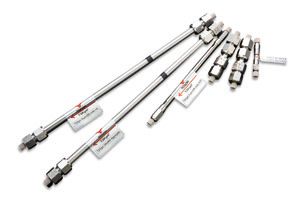Setting new Benchmarks for Antibody Analysis
Tosoh Bioscience expands the renowned TSKgel SW series of aqueous size exclusion HPLC columns by three new UHPLC columns, tailored to different aspects of antibody analysis.

Tosoh Bioscience expands the renowned TSKgel SW series of aqueous size exclusion HPLC columns by three new UHPLC columns, tailored to different aspects of antibody analysis.
Aqueous SEC on silica based stationary phases is state of the art for aggregation analysis. TSKgel G3000SWXL is regarded as the gold standard of antibody SEC columns. In an ongoing approach to adopt stationary phases to the user’s needs, the proven surface chemistry of the TSKgel SW series was used to developed new UHPLC columns.
TSKgel SuperSW mAb HTP - ‘HTP’ for high throughput - was developed to enable easy transfer of HPLC methods based on TSKgel SWXL to fast UHPLC analysis. Small particle size silica beads featuring the same pore size and coating as G3000SWXL are packed in UHPLC column hardware with 4.6 mm inner diameter. This allows for doubling the throughput without compromising resolution between monomer and dimer. Another approach was used in the development of TSKgel SuperSW mAb HR - ‘HR’ indicating high resolution. The SuperSW stationary phase was packed in columns featuring the traditional dimensions for HPLC gel filtration columns of 7.8 mm ID and 30 cm length. This results in superior resolution between fragments, monomers, and aggregates. TSKgel UltraSW Aggregate covers the range of higher molecular weights and provides very good separation of antibody dimers and higher aggregates. It is based on even smaller silica beads with slightly larger pore size.
The new columns are ideally used in UHPLC instruments, even though the columns will not create back pressures exceeding the pressure limits of standard HPLC systems.
Polysorbate Quantification and Degradation Analysis via LC and Charged Aerosol Detection
April 9th 2025Scientists from ThermoFisher Scientific published a review article in the Journal of Chromatography A that provided an overview of HPLC analysis using charged aerosol detection can help with polysorbate quantification.
Analyzing Vitamin K1 Levels in Vegetables Eaten by Warfarin Patients Using HPLC UV–vis
April 9th 2025Research conducted by the Universitas Padjadjaran (Sumedang, Indonesia) focused on the measurement of vitamin K1 in various vegetables (specifically lettuce, cabbage, napa cabbage, and spinach) that were ingested by patients using warfarin. High performance liquid chromatography (HPLC) equipped with an ultraviolet detector set at 245 nm was used as the analytical technique.
Removing Double-Stranded RNA Impurities Using Chromatography
April 8th 2025Researchers from Agency for Science, Technology and Research in Singapore recently published a review article exploring how chromatography can be used to remove double-stranded RNA impurities during mRNA therapeutics production.





